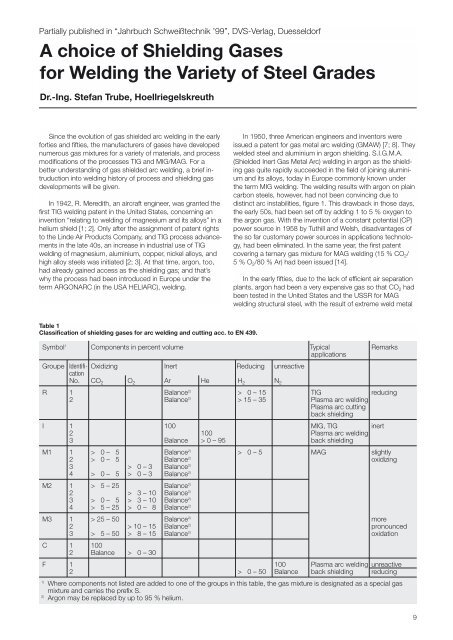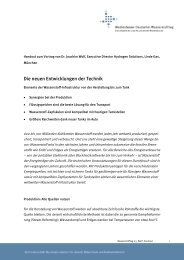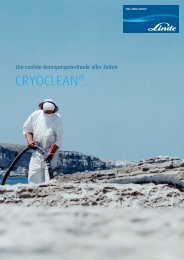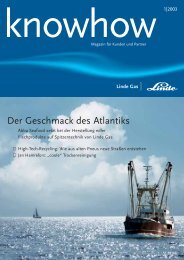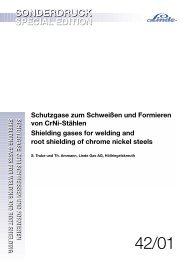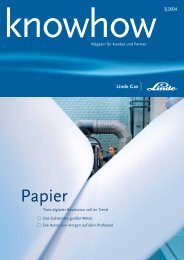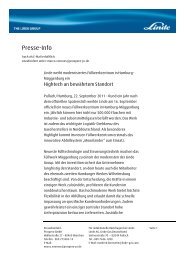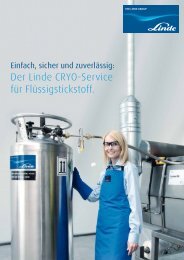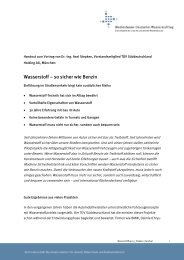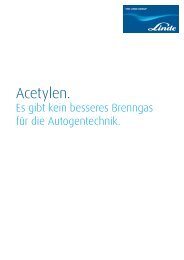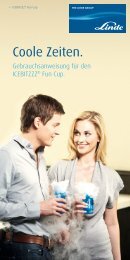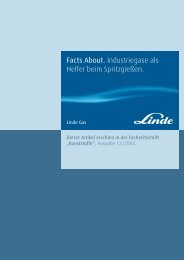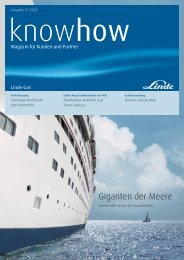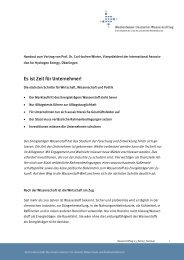Auswahl von Schutzgasen zum Schweißen von Stahlwerkstoffen A ...
Auswahl von Schutzgasen zum Schweißen von Stahlwerkstoffen A ...
Auswahl von Schutzgasen zum Schweißen von Stahlwerkstoffen A ...
Sie wollen auch ein ePaper? Erhöhen Sie die Reichweite Ihrer Titel.
YUMPU macht aus Druck-PDFs automatisch weboptimierte ePaper, die Google liebt.
Partially published in “Jahrbuch Schweißtechnik ’99”, DVS-Verlag, Duesseldorf<br />
A choice of Shielding Gases<br />
for Welding the Variety of Steel Grades<br />
Dr.-Ing. Stefan Trube, Hoellriegelskreuth<br />
Since the evolution of gas shielded arc welding in the early<br />
forties and fifties, the manufacturers of gases have developed<br />
numerous gas mixtures for a variety of materials, and process<br />
modifications of the processes TIG and MIG/MAG. For a<br />
better understanding of gas shielded arc welding, a brief intruduction<br />
into welding history of process and shielding gas<br />
developments will be given.<br />
In 1942, R. Meredith, an aircraft engineer, was granted the<br />
first TIG welding patent in the United States, concerning an<br />
invention “relating to welding of magnesium and its alloys” in a<br />
helium shield [1; 2]. Only after the assignment of patent rights<br />
to the Linde Air Products Company, and TIG process advancements<br />
in the late 40s, an increase in industrial use of TIG<br />
welding of magnesium, aluminium, copper, nickel alloys, and<br />
high alloy steels was initiated [2; 3]. At that time, argon, too,<br />
had already gained access as the shielding gas; and that’s<br />
why the process had been introduced in Europe under the<br />
term ARGONARC (in the USA HELIARC), welding.<br />
Table 1<br />
Classification of shielding gases for arc welding and cutting acc. to EN 439.<br />
In 1950, three American engineers and inventors were<br />
issued a patent for gas metal arc welding (GMAW) [7; 8]. They<br />
welded steel and aluminium in argon shielding. S.I.G.M.A.<br />
(Shielded Inert Gas Metal Arc) welding in argon as the shielding<br />
gas quite rapidly succeeded in the field of joining aluminium<br />
and its alloys, today in Europe commonly known under<br />
the term MIG welding. The welding results with argon on plain<br />
carbon steels, however, had not been convincing due to<br />
distinct arc instabilities, figure 1. This drawback in those days,<br />
the early 50s, had been set off by adding 1 to 5 % oxygen to<br />
the argon gas. With the invention of a constant potential (CP)<br />
power source in 1958 by Tuthill and Welsh, disadvantages of<br />
the so far customary power sources in applications technology,<br />
had been eliminated. In the same year, the first patent<br />
covering a ternary gas mixture for MAG welding (15 % CO 2/<br />
5 % O 2/80 % Ar) had been issued [14].<br />
In the early fifties, due to the lack of efficient air separation<br />
plants, argon had been a very expensive gas so that CO 2 had<br />
been tested in the United States and the USSR for MAG<br />
welding structural steel, with the result of extreme weld metal<br />
Symbol 1 Components in percent volume Typical Remarks<br />
applications<br />
Groupe Identifi- Oxidizing Inert Reducing unreactive<br />
cation<br />
No. CO 2 O 2 Ar He H 2 N 2<br />
R 1 Balance 2) > 0 – 15 TIG reducing<br />
2 Balance 2) > 15 – 35 Plasma arc welding<br />
Plasma arc cutting<br />
back shielding<br />
I 1 100 MIG, TIG inert<br />
2 100 Plasma arc welding<br />
3 Balance > 0 – 95 back shielding<br />
M1 1 > 0 – 5 Balance 2) > 0 – 5 MAG slightly<br />
2 > 0 – 5 Balance 2) oxidizing<br />
3 > 0 – 3 Balance 2)<br />
4 > 0 – 5 > 0 – 3 Balance 2)<br />
M2 1 > 5 – 25 Balance 2)<br />
2 > 3 – 10 Balance 2)<br />
3 > 0 – 5 > 3 – 10 Balance 2)<br />
4 > 5 – 25 > 0 – 8 Balance 2)<br />
M3 1 > 25 – 50 Balance 2) more<br />
2 > 10 – 15 Balance 2) pronounced<br />
3 > 5 – 50 > 8 – 15 Balance 2) oxidation<br />
C 1 100<br />
2 Balance > 0 – 30<br />
F 1 100 Plasma arc welding unreactive<br />
2 > 0 – 50 Balance back shielding reducing<br />
1) Where components not listed are added to one of the groups in this table, the gas mixture is designated as a special gas<br />
mixture and carries the prefix S.<br />
2) Argon may be replaced by up to 95 % helium.<br />
9


